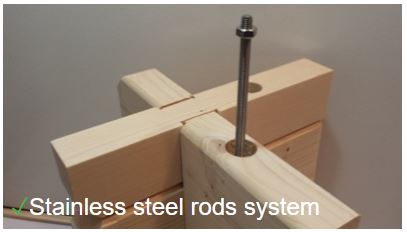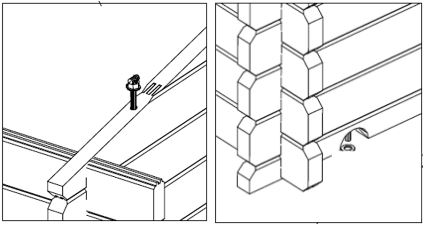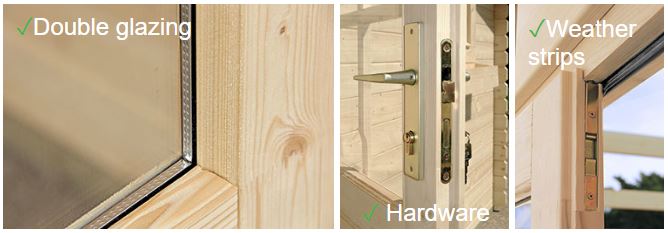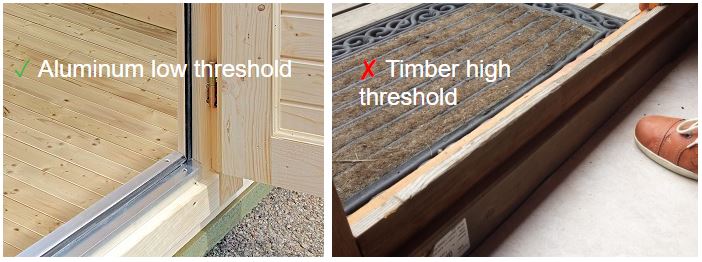The popularity and recognition of Scandinavian backyard cabins, commonly known as log cabins in Australia are quite impressive. They are popular all over around the World for their sustainability and speed of installation.
Log cabins were introduced to Australia only recently, most likely due to remoteness of the continent and the policy of protecting economy liberating only after 1973. Australian consumers now get to enjoy new and innovative products the World has been enjoyed for centuries. However, not so good products are flooding a new Australian market as well. This article will help to identify the points of difference to look for when comparing log cabins available in Australia.
What to look for when comparing log cabins from different factories?
There are quite a few different manufacturers in Europe, China and even New Zealand offering their backyard cabin kits. From first sight, cabins imported from overseas might appear all very similar. However, some sneaky hidden and also visible features will make a huge difference in the structural integrity, energy efficiency and the longevity of your cabin.
So, there are five major things to look for when comparing backyard cabins from different suppliers/manufacturers. Visit of a display to inspect the product is always a good idea before purchase.
Expert tip: ask the manufacturer for the weight of the kit, the part that comes from Europe. Amount of timber and the quality of windows and doors will make a huge difference in how much it weights.
1. Compliance with Australian Building Codes
YZY Kit Homes are designed in accordance with National Construction Code, structural requirements and wind loads. Windows have been manufactured to comply with AS2047 (Windows in buildings – Selection and installation), AS1288 (Glass in buildings – Selection and installation) and AS1170.1(Structural design actions).
2. Timber species and moisture content
Cheaper backyard cabins are usually made from Pine, material that is least stable softwood used in construction. Pine Timber has large knots and is darker in colour compared to superior material Nordic Spruce used for quality buildings.

Nordic Spruce is a more expensive material when compared to Pine. However, it is the best softwood you can get. Spruce trees grow in the Northern part of Europe where the climate is cold, and trees grow slowly saving the energy and producing a few thin limbs resulting in more stable timber with small knots.
Moisture content in timber is another important thing to look for. Cheaper cabins will be made of timber with greater moisture content. This will result in excessive shrinkage, which naturally creates cracks and gaps in a structure.
3. Structural tie-down system with steel rods and engineering
You can find many different levels of quality of Scandinavian structure cabins in Europe. Some manufacturers produce well-engineered quality cabins, and others focus on cheap shed-type temporary shelters. If you are looking for the solid structure system for years to last, look for a structure designed with steel rods tie-down system that runs through walls from top to bottom holding the wallboards tight but at the same time allowing natural timber movement. Residential homes in Europe, USA and New Zealand use the same tie-down system for decades. In Australia, some builders are screwing boards to each other. No manufacturer of log cabins would recommend that. Screws will loosen fairly quickly due to timber movement, the building may become structurally unsound and prone to water penetration.


Another important structural component to look for is roof rafters. Check the number and the thickness of the beams. Rafters are keeping all building structurally sound, square and plumb. Always choose cabins with more and thicker rafters when possible.
4. Quality of Doors and Windows

Windows and doors. Look for overall quality and size of windows and doors. Quality is quite easy to compare, but also ask or measure the height of the doors, size of windows. Cheaper cabins usually come with lower doors that are not compliant with Australian Standards. Also, inspect door and window handles, opening mechanisms.
Hardware. Quality windows and doors will be made with German-made Roto hardware that has multi-point locking systems.
Weatherstripping. Now let’s get to the details that are very important and makes a massive difference in the quality of the cabin you want to enjoy for years to come. Pay attention if windows and doors have weather strips that stop heat/cold, dust, insects, noise and rain – very important for energy efficiency and that extra lift in comfort.
Glass. Ask what glass is used in the windows. Does it comply with AU/NZ standards, is it tempered/safety glass. What the parameters are of double glazing. The standard European glazing is 4/16/4mm.
5. Wall thickness and ceiling height
Check the difference in wall thickness. Summerhouses and backyard studios are usually manufactured in 45mm solid timber walls. Granny flats and Homes are made with laminated LGL timber 60, 80, 95, 120 and 140mm thickness milled logs. Calculate the percentage of the difference in thickness to compare. For example, if the difference is 30%, that’s how much better comfort inside in terms of insulation and soundproof you will have. Combine it with well-weatherproofed quality double glazed windows, and you have the best backyard cabin you ever wished for.
Compare the ceiling height. The space is so much airy and comfortable with the higher ceilings. Cheaper cabins tend to have lower walls, and it feels a bit cramped inside. But if you are going to use it for storage, that should be fine. However, if you are after a guest accommodation or a hobby room, to comply with AU/NZ standards, for a habitable room, an average ceiling height must be 2.4m.
Threshold: height and material
Other thing to consider is the threshold. Quality backyard cabins and granny flats have aluminium thresholds whereas inferior cabins have timber threshold made of the same softwood which wears out quite fast, resulting in gaps and door opening and closing problems.

Also, the height of the threshold is a significant feature to look at as you don’t want to snag on the doorstep.
Feel free to contact our selected builder for advice. Find your nearest builder click here
